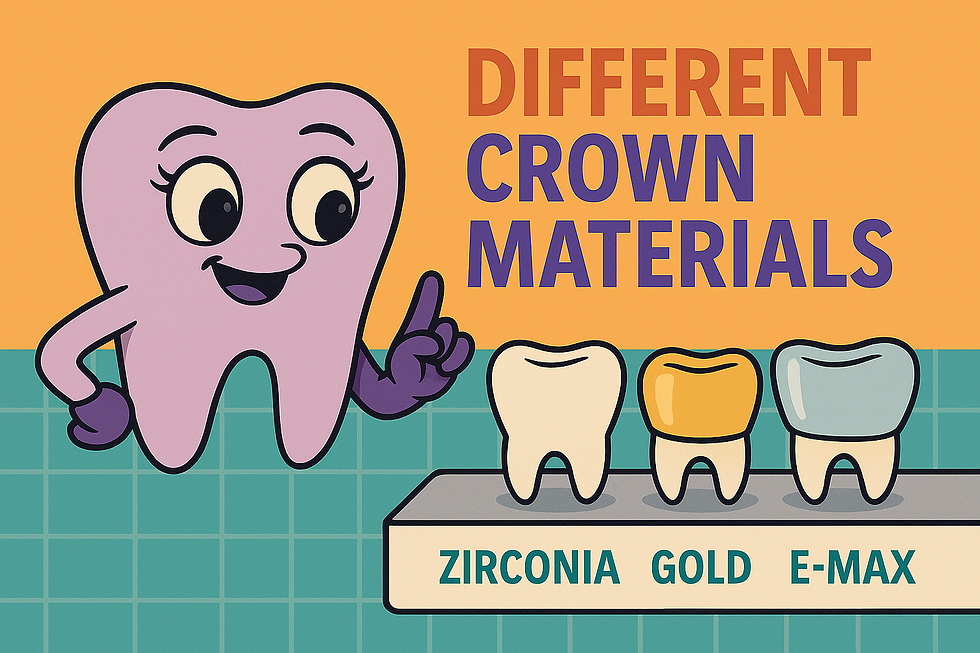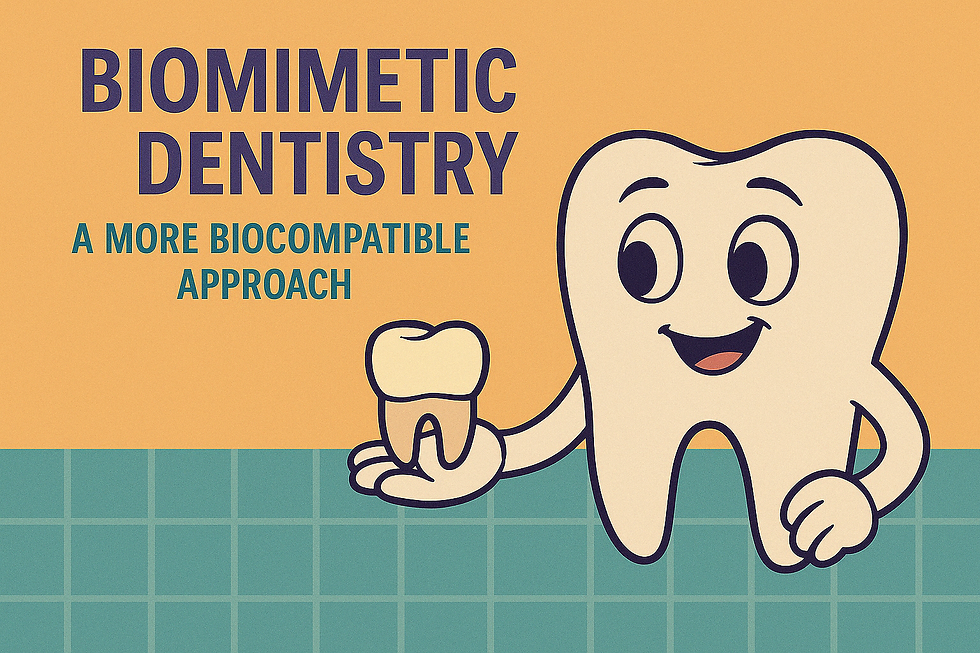Gold, Zirconia, Emax & More: What's Really On Your Tooth?
- naytoghlo
- Apr 23
- 4 min read
Updated: May 6

Hello everyone, this is Dr. Noor!
So, you need a crown! Maybe your tooth had a large filling, underwent a root canal, or decided to chip unexpectedly (how rude!). A crown, often called a cap, is like a custom-made helmet for your tooth, restoring its shape, size, strength, and appearance. But once you know you need one, the next question often is: "What's it made of?"
It's not quite like picking jewelry, though some options are literally gold! The world of crown materials can seem complex, with options ranging from metals to high-tech ceramics. Let's break down the common players in the crown game:
1. The Golden Oldie: Gold Crowns
Yes, actual gold (well, gold alloyed with other metals for strength)! These have been used for ages, and for good reason.
Pros: Incredibly durable, kind to opposing teeth (wears down at a similar rate), very biocompatible (your gums usually love it), requires less tooth reduction sometimes.
Cons: The obvious one – it's gold-colored! Not everyone's aesthetic choice, especially near the front of the mouth. Cost can be higher due to the price of gold.
When Used: Often the top choice for back molars where biting forces are high and aesthetics are less critical. For people who grind heavily, gold is a fantastic, long-lasting option.
Fun Fact: Gold crowns aren't pure 24k gold (too soft!). They're alloys, often mixed with metals like palladium, platinum, or silver to make them tough enough for chewing!
2. The Hybrid Hero: Porcelain-Fused-to-Metal (PFM)
Think of this as a metal helmet wearing a tooth-colored porcelain coat.
Pros: Good strength from the metal substructure, combined with decent aesthetics from the porcelain overlay. A long-standing, reliable option.
Cons: The metal base means they aren't as translucent as natural teeth or all-ceramics. Sometimes, a dark line can become visible at the gumline if gums recede. The porcelain layer can potentially chip or fracture over time.
When Used: Very versatile! Used on both front and back teeth, and often used for bridges. A solid workhorse crown.
Fun Fact: The process of bonding porcelain to metal involves firing it at extremely high temperatures, creating a strong chemical bond between the two layers.
3. The Beauty Queen: Emax (Lithium Disilicate)
This is a type of all-ceramic crown known for its stunning looks.
Pros: Excellent aesthetics! It's highly translucent, mimicking the appearance of natural tooth enamel beautifully. Great biocompatibility.
Cons: While strong, it's generally not quite as fracture-resistant as zirconia or gold, making it less ideal for heavy grinders or back molars under extreme stress.
When Used: The star player for front teeth where appearance is paramount. Also used for veneers and sometimes inlays/onlays.
Fun Fact: Emax gets its beautiful appearance partly because light can travel through it similarly to a natural tooth, giving it a lifelike quality often called the "chameleon effect."
4. The Tough Guy: Zirconia
Another all-ceramic option, but this one is known for its brute strength.
Pros: Extremely strong and durable (great for molars!), decent to good aesthetics (improving all the time!), very biocompatible. Can often be made thinner than PFM, sometimes preserving more natural tooth.
Cons: Can be so strong that older formulations were sometimes abrasive to opposing natural teeth (newer formulations are much better!). Can be less translucent than Emax, appearing slightly more opaque.
When Used: Fantastic for posterior teeth (molars/premolars) needing strength, good for bridges, and increasingly used in anterior areas too as aesthetics improve. A go-to for durability.
Fun Fact: Zirconia is so tough and biocompatible it's sometimes called "ceramic steel" and is also used in medical applications like hip replacements!
5. The Kid Cap: Stainless Steel Crowns (SSC)
These are usually pre-fabricated shells used primarily in pediatric dentistry.
Pros: Very durable for baby teeth, cost-effective, quick to place (often done in one visit). Protects the tooth until it naturally falls out.
Cons: They are silver-colored, which is purely functional, not aesthetic. Only suitable for primary (baby) teeth.
When Used: On baby molars with large cavities, after nerve treatment on baby teeth, or on teeth that didn't form properly.
Fun Fact: Dentists often call these "silver crowns" or "space helmets" when talking to kids to make them sound cooler!
What About the Cost? Is Gold Really That Much More?
Here's the interesting part: while gold alloy crowns often carry a higher price tag due to the metal cost, and stainless steel crowns are the most economical (for their specific use), the costs for PFM, Emax, and Zirconia can often be surprisingly similar!
Why? Because the final cost depends on lab fees (which vary), the complexity of your specific case, and the dentist's time and expertise. Sometimes, the advanced technology needed to mill beautiful Emax or Zirconia crowns balances out the material costs compared to the traditional lab work for a PFM.
The bottom line is: the clinical situation is almost always the most important factor in choosing a material. We need to consider:
Where is the tooth located? (Front vs. Back)
How much force will it endure? (Are you a grinder?)
How much natural tooth structure is left?
What are the aesthetic requirements?
While cost is a valid consideration, the goal is to choose the material that gives your tooth the best chance for long-term health and function in your specific circumstances. We want that crown to serve you well for years to come!
So, don't hesitate to ask questions about why a particular material is being recommended for you. Understanding the 'why' behind the choice helps you appreciate the 'crown jewel' that's restoring your smile!
Keep smiling, and here's to strong, happy teeth!
Warmly,
Dr. Noor N. Ay Toghlo



Comments